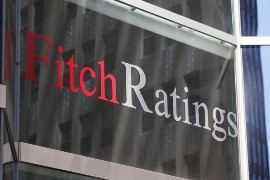Analytics, Estonia, Financial Services, Investments, Rating
International Internet Magazine. Baltic States news & analytics
Thursday, 18.04.2024, 04:16
Fitch affirms Estonia at A+ rating
 Print version
Print version |
|---|
The agency has also affirmed the Short-term foreign currency rating at 'F1' and Country Ceiling at 'AAA'. The latter is common to all eurozone member countries except Greece, Fitch Ratings said in a press release.
"The affirmation of Estonia's sovereign ratings with Stable Outlooks reflect the country's near seamless transition to full membership of the eurozone starting on 1 January 2011, coupled with a more balanced economic recovery and the continued deleveraging of the private sector," says Paul Rawkins, Senior Director in Fitch's Sovereign Ratings group, informs LETA.
"However, income per capita is still relatively low and the economy continues to display a high level of volatility, while the risk of contagion associated with a potential Greek exit from the eurozone clouds the near term outlook," adds Rawkins.
Fitch notes that Estonia's first 18 months of eurozone membership have been fairly trouble-free, notwithstanding the currency union's broader travails. Estonia recorded the highest growth rate (7.6%) in the eurozone in 2011 on the back of strong export-led expansion. Euro area membership has reduced the risk of a balance of payments crisis, simultaneously raising the profile of Estonia's key rating attributes: fiscal conservatism, economic flexibility and underlying political and institutional strengths.
Fitch believes that the key near-term risk for Estonia arises from developments in the broader eurozone and the potential repercussions of a Greek exit. Estonia is much more resilient than it was to external shocks: 'internal devaluation' has restored external competitiveness; public finances are among the strongest in the eurozone; private sector deleveraging is well underway; and the foreign-owned financial sector has absolved the sovereign of contingent liabilities. Nonetheless, for a small, open economy with close links to the eurozone and the EU, the risks of contagion through trade and financial channels could be material.
Fitch notes that the defining difference between the current recovery and the previous boom and bust has been the absence of macroeconomic imbalances. The current account balance has remained in surplus, credit to the private sector is still contracting and the capital account has been dominated by a surge in net FDI, balanced by large net external debt repayments. However, weaker export growth since Q411 reflects the crisis in the eurozone and growth is set to slow to around 2% in 2012.
Public finances stand out as Estonia's key rating strength and have assumed added significance in the eurozone context. A second consecutive year of budget surplus in 2011 (1% of GDP) was attributable in part to one-off factors while, at 6% of GDP in 2011, Estonia retains the lowest public debt levels in the EU. Public debt is set to rise sharply to 11% by 2013 as Estonia assumes its share of liabilities associated with EFSF funding and modest budgetary pressures re-emerge. Nonetheless, fiscal surpluses should be restored by 2014, while public debt levels should remain well within the confines of 'A' medians.
A longer track record of strong economic growth without significant macroeconomic imbalances, coupled with a continued decline in gross and net external debt, could eventually lead to an upgrade. Conversely, significant reversals in these areas could put downward pressure on the ratings.
Fitch believes a full break-up and demise of the eurozone remains unlikely. However, in the event of a heightened probability of Greek exit from the eurozone, Fitch stated on 3 May that it would put the ratings of all 17 member states, including Estonia, on Rating Watch Negative (RWN). Resolution of the RWN would depend on the individual country's starting position, the degree of contagion and the manner in which the broader crisis was handled within the eurozone.








 «The Baltic Course» Is Sold and Stays in Business!
«The Baltic Course» Is Sold and Stays in Business!

